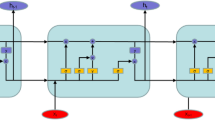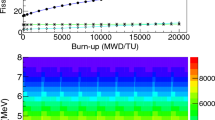Abstract
Abstract-Using of machine learning (ML) and deep learning (DL) techniques in data analysis becomes a mainstream today and is presented in papers of leading experiments. These modern methods allow sometimes to increase the accuracy of, for example, mass composition reconstruction significantly. In current work DL are applied for core location based on data of ENDA array CORSIKA + GEANT4 Monte Carlo simulations. ENDA (Electron Neutron Detector Array) is an extensive air shower (EAS) experiment based on idea of simultaneous recording of electromagnetic component of EAS and thermal neutrons produced by the hadron component of the shower. Results of the analysis are presented.



Similar content being viewed by others
REFERENCES
M. I. Jordan and T. M. Mitchell, Science (Washington, DC, U. S.) 349 (6245), 255 (2015).
D. George and E. A. Huerta, Phys. Rev. D 97, 044039 (2018).
D. Ivanov, O. E. Kalashev, M. Yu. Kuznetsov, G. I. Rubtsov, T. Sako, Y. Tsunesada, and Y. V. Zhezher, Mach. Learn.: Sci. Technol. 2, 015006 (2021).
M. Erdmann, J. Glombitza, and D. Walz, Astropart. Phys. 97, 46 (2018).
K. Andeen and M. Plum, EPJ Web Conf. 210, 03005 (2019).
Y. Li, Z. Hao, and H. Lei, J. Comput. Appl. 36, 9 (2016).
Yu. Stenkin, arXiv: 0902.0138.
Yu. Stenkin, V. Alekseenko, Danzengluobu, L. Zhang, D. Kuleshov, K. Levochkin, B. Li, M. Liu, Ye Liu, X. Ma, D. Xiao, O. Shchegolev, S. Cui, T. Chen, C. Shi, and F. Yang, Bull. Russ. Acad. Sci.: Phys. 85, 405 (2021).
Xinhua Ma, Jiancheng He, Yi Zhang, Youliang Feng, Yiqing Guo, Hongbo Hu, Cheng Liu, Shu-Wang Cui, Bing-Bing Li, Shuai Liu, Cong Shi, Ye Liu, V. Alekseenko, K. Levochkin, V. Rulev, O. Shchegolev, et al. (for LHAASO Colab.), PoS (ICRC2019) 345.
X. Ma, O. B. Shchegolev, and Y. V. Stenkin, PoS (ICRC2019) 431.
Yu. V. Stenkin, Phys. At. Nucl. 71, 98 (2008).
Author information
Authors and Affiliations
Corresponding author
Rights and permissions
About this article
Cite this article
Shchegolev, O. Deep Learning Techniques Applications for the ENDA Experiment Data Analysis. Phys. Atom. Nuclei 84, 915–918 (2021). https://doi.org/10.1134/S1063778821130317
Received:
Revised:
Accepted:
Published:
Issue Date:
DOI: https://doi.org/10.1134/S1063778821130317




